By Hope Imaka – EMTV Online
Papua New Guinea Resident Mission’s Country Economist, Yurendra Basnett, discussed PNG’s latest economic and fiscal outlook from the view of the Asian Development Bank (ADB).
From January through to July, and now at the close of the year, consistent revision to growth projections had been carried out.
2015 started off with a very high figure of 15 per cent, mid-year into July revised down to 11 per cent, and now according to ADB projection, estimates fall to around 9 per cent.
In 2016, ADB predicts a growth of just 3 per cent, of which the bulk of which will come from the agriculture sector.
WHAT HAPPENED?
Firstly, Papua New Guinea being a commodity exporting country was not immune to the substantial downward slide in oil prices experienced this year.
With the supply of oil not adjusting any time soon, according to the OPEC meeting this year, stock prices remain high.
As global demand remains soft, export commodities and commodity exporting countries are going to face a very big global demand, which is going to translate the economy.
The second issue is the inevitable rate rise by the US Federal Bank. Consensus says that the US will increase its rate in December, or mid-December, which will immediately transfer into a stronger US dollar.
THE MEDIUM TERM GROWTH OUTLOOK
This is an important phase or cycle that the economy is going through.
According to Basnett, the fundamentals remain strong for the medium-term growth outlook.
In 2016, growth is estimated to be small, relative to the rather long episode of economic growth that PNG faced.
Weak commodities have affected the external sector, due to the global demand for commodities and low oil prices. What we see is that export prices are reducing which in turn affects the export sector.
The Balance of Payment that had been expected to do well on the back of the LNG exports this year failed to reach the anticipated amount as projected by the country, largely due to the large drop in commodity prices.
In light of this fact, we can conclude that the economy of Papua New Guinea relies quite largely on what happens to commodity prices.
FISCAL POLICY
The fiscal outlook has deteriorated in the first half of 2015. With no adjustment to budgeted expenditure in 2015, the fiscal position is expected to be a deficit of K4,817.1 million or – 9.4 per cent of GDP, which is an increase of K2,545.6 million compared to the initial deficit of K2,271.8 million or – 4.4 per cent of GDP at the time of the 2015 Budget.
According to Basnett, the government of Papua New Guinea has indeed taken the right course of action in order to push the balance of the budget from an earlier target date a year out from 2017, now out to 2020. That way it will the restrain choking the economic growth momentum.
The growth in expenditure has reduced, and it is in line with the 2020 strategy of the government bringing the books into balance.
Recognising the fact that 88 per cent of the people in PNG are located in the rural areas, Basnett pointed out that the largest increase in budget allocation has been to provinces.
“…we want to see larger shares of fiscal expenditures going out to the rural areas…”
Ensuring that these expenditures are accompanied by appropriate plans, designs and strategies must be done to ensure that it is effective in delivering development results.
Basnett points out the important areas of the government budget are:
- Quality of Expenditure
- Delivering Results
- Monitoring and Evaluation of Results
“How quickly and how effectively you can get the funds out will determine how you can soften some of the impacts of growth reduction in terms of employment and in terms delivery of basic services.”
2016 BUDGET
According to Basnett, there are risks to the 2016 budget. These risks include:
- The continuation of low commodity prices
- Soft global demands
- Contraction in US Monitory Policies
- Weak budget execution
On the upside, ADB believes the strategy that has been drafted by the government is ideal, responds to the global situation well and now requires proper execution.
More efficient public spending could yield savings. It is estimated that up to K700 weeding out nonperforming workers and spurious posts could save million. Each year, the government places a sizeable part of the budget in commercial bank trust accounts. Not only are these subject to service fees, banks also use the cash to purchase Treasury Bills when the government faces cash flow problems. This reportedly costs the Treasury over K1 billion, which could be avoided through better planning and budget implementation.
WHAT DOES ADB WANT TO SEE?
- Growth to be More Inclusive; greater labour participation is important for that to happen.
- Greater commercialisation of private sector participation


